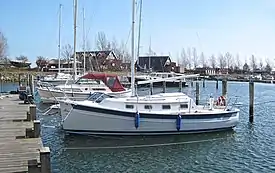Seaward 25
The Seaward 25 is an American trailerable sailboat that was designed by Nick Hake a cruiser and first built in 1984.[1]
 | |
| Development | |
|---|---|
| Designer | Nick Hake |
| Location | United States |
| Year | 1984 |
| No. built | 600 |
| Builder(s) | Hake Yachts |
| Boat | |
| Boat weight | 3,600 lb (1,633 kg) |
| Draft | 2.08 ft (0.63 m) |
| Hull | |
| Type | Monohull |
| Construction | Fiberglass |
| LOA | 26.75 ft (8.15 m) |
| LWL | 23.00 ft (7.01 m) |
| Beam | 8.33 ft (2.54 m) |
| Engine type | Yanmar diesel engine or outboard motor |
| Hull appendages | |
| Keel/board type | fin keel |
| Ballast | 1,200 lb (544 kg) |
| Rudder(s) | transom-mounted rudder |
| Rig | |
| Rig type | Bermuda rig |
| I (foretriangle height) | 25.50 ft (7.77 m) |
| J (foretriangle base) | 8.75 ft (2.67 m) |
| P (mainsail luff) | 25.92 ft (7.90 m) |
| E (mainsail foot) | 10.42 ft (3.18 m) |
| Sails | |
| Sailplan | Fractional rigged sloop |
| Mainsail area | 135.04 sq ft (12.546 m2) |
| Jib/genoa area | 111.56 sq ft (10.364 m2) |
| Total sail area | 246.61 sq ft (22.911 m2) |
Production
The design was built by Hake Yachts of Stuart, Florida starting in 1984, with 600 boats completed before production ended. The company later re-located to Largo, Florida, United States and was renamed the Starboard Yacht Company, when they bought out Island Packet Yachts.[1][2]
Design
The Seaward 25 is a recreational keelboat, built predominantly of fiberglass. It has a fractional sloop rig with aluminum spars. The hull has plumb stem and a plumb transom, with a transom-hung rudder controlled by a wheel and a fixed fin keel. It displaces 3,600 lb (1,633 kg) and carries 1,200 lb (544 kg) of ballast.[1]
The boat has a draft of 2.08 ft (0.63 m) with the standard shoal draft keel fitted or 4.17 ft (1.27 m) with the deep "bluewater" keel.[1][3]
The boat may be optionally fitted with a Japanese Yanmar diesel inboard engine or a small outboard motor for docking and maneuvering.[1]
The design has sleeping accommodation for four people, with a double "V"-berth in the bow cabin, a straight settee in the main cabin and an aft berth on the port side. The galley is located on the port side just forward of the companionway ladder. The galley is angled and is equipped with a two-burner stove and a sink. The head is located on the starboard side.[1]
Operational history
Darrell Nicholson, the editor of Practical Sailor, did a review of the boat in 2003. He described sailing it, writing, "we sailed in 8-10 knots of wind, flying a 135-percent genoa, the maximum recommended by the designer, and full mainsail. The helm was responsive, and the boat quickly accelerated with the occasional puff of breeze. In a steady breeze we sailed at 4-5 knots on a reach. Hardening up and pushing to within 45 degrees of the wind, speed dropped by about a knot. We couldn’t record precise speeds because of a dirty speedo impeller. In fact, it was hard to get an accurate feel for her performance altogether, because the river current flows into the prevailing winds. However, sailing cross-current on a beam reach, she showed good speed, helm balance, and tracking. We’d like to take a longer sail to weather in open water. She did provide a comfortable ride, especially when compared to water- ballasted trailerables, and was easy to sail with little muscular effort."[4]
In a 2000 review in Sailing Magazine, writer John Kretschmer, wrote, "we hauled up the main and optional 135-percent genoa and, with a joy that only small boats provide, sailed away from the dock. While the Seaward 25 offers the ease of handling and overall lack of fuss associated with most small boats, it also has several features usually reserved for larger boats. From wheel steering to diesel power to hot and cold pressure water to the surprisingly comfortable interior, the Seaward has the feel of a larger boat. I could happily spend a few weeks aboard a Seaward 25 exploring a bit of thin turquoise water in the Bahamas."[3]
References
- McArthur, Bruce (2020). "Seaward 25 sailboat". sailboatdata.com. Archived from the original on 15 September 2020. Retrieved 15 September 2020.
- McArthur, Bruce (2020). "Hake Yachts (Seaward)". sailboatdata.com. Archived from the original on 13 September 2020. Retrieved 15 September 2020.
- Kretschmer, John (7 July 2000). "Seaward 25". Sailing Magazine. Archived from the original on 15 September 2020. Retrieved 15 September 2020.
- Nicholson, Darrell (8 January 2003). "Seaward 25". Practical Sailor. Archived from the original on 15 September 2020. Retrieved 15 September 2020.
External links
 Media related to Seaward 25 at Wikimedia Commons
Media related to Seaward 25 at Wikimedia Commons